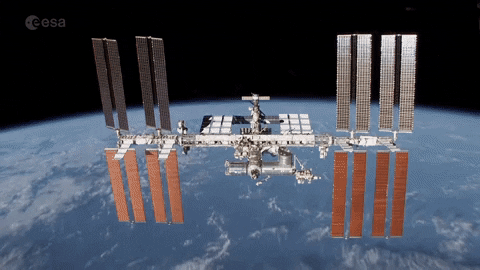ISS - Expedition 64 Mission patch.
Mar 26, 2021
The week of March 22, crew members aboard the International Space Station tested a blood cell count device, examined time perception in space, and videotaped activities to promote awareness of space station research. The crew also began preparations for the arrival of Expedition 65 crew members, NASA astronaut Mark Vande Hei and cosmonauts Oleg Novitskiy and Pyotr Dubrov, scheduled for April 9.
The seven crew members currently inhabiting the station include four from NASA’s Commercial Crew Program, providing increased crew time for science activities on the orbiting lab. The space station has been continuously inhabited by humans for 20 years and has supported many scientific breakthroughs during that time. The station provides a platform for long-duration research in microgravity and for learning to live and work in space, experience that supports Artemis, NASA’s program to go forward to the Moon and on to Mars.
International Space Station (ISS). Animation Credit: ESA
Here are details on some of the microgravity investigations currently taking place:
Counting blood cells
The crew analyzed samples for HemoCue, which tests the ability of a commercially available device to provide quick and accurate blood cell counts in microgravity. Physicians routinely use blood cell counts to diagnose different diseases and monitor a variety of health conditions on Earth. On future exploration missions, this capability could allow crews to identify certain medical conditions, diagnose illnesses, monitor conditions such as infections or radiation exposure, track treatment response, and assess the severity of an illness.
Time flies when you’re in space
Spaceflight alters our perception of space and time. Crew members routinely under-estimate distances during and shortly after flight, move more slowly at the beginning of a flight, and report that time seems to move faster in space. Accurate perception of objects in the environment and of the passage of time is fundamental to reliable performance of motor tasks during a mission. An experiment from ESA (European Space Agency), Time Perception quantifies subjective changes in this perception during and after long-duration exposure to microgravity. During the week, crew members conducted sessions for the experiment.
Science, camera, action
Image above: This image taken by JAXA astronaut Soichi Noguchi from the space station cupola shows the islands of Japan. Image Credit: NASA.
Crew members recorded various experiment activities for the Japan Aerospace Exploration Agency (JAXA) EPO 7 project during the week. JAXA EPO7 demonstrates educational events and artistic activities aboard the space station to enlighten the general public about microgravity research and human space flight. The demonstrations are downlinked, edited, and used to support cultural resources for the general public. The program introduces the next generation of explorers to the environment of space and helps contribute to developing a global citizenry, expanding the future of mankind through space exploration.
Other investigations on which the crew performed work:
Image above: The ISS Experience is creating an immersive virtual reality (VR) series documenting life and research aboard the space station using customized 360-degree cameras, including this one shown on the space station. Image Credit: NASA.
- The ISS Experience uses footage captured by crew members to create an immersive virtual reality series documenting life and research aboard the space station. The first episode premiered in fall 2020 on multiple platforms and episode 2, “Advance,” releases on March 29.
https://www.nasa.gov/mission_pages/station/research/experiments/explorer/Investigation.html?#id=7877
Animation above: NASA astronaut Michael Hopkins fills sample wells for the RTPCG-2 investigation into new methods for producing high-quality protein crystals in microgravity. Animation Credit: NASA.
- RTPCG-2 demonstrates new methods for producing high-quality protein crystals in microgravity for analysis on Earth to identify possible targets for drugs to treat disease.
https://www.nasa.gov/mission_pages/station/research/experiments/explorer/Investigation.html?#id=8073
- An investigation from the Japan Aerospace Exploration Agency (JAXA), Asian Herb in Space studies several fast-growing plants used for traditional medicine and flavoring food, examining differences in their aroma that may result from microgravity-related cellular changes. Results could benefit future plant growth efforts in space.
https://www.nasa.gov/mission_pages/station/research/experiments/explorer/Investigation.html?#id=2052
- Ribosome Profiling, an investigation from JAXA, aims to provide insight into how gravity affects gene expression, with a special focus on translation regulation, using a state-of-art technique. The work could help researchers understand why aging-related changes often occur in space and may lead to better treatments for those changes.
https://www.nasa.gov/mission_pages/station/research/experiments/explorer/Investigation.html?#id=7985
- Standard Measures collects a set of core measurements from astronauts before, during, and after long-duration missions to create a data repository to monitor and interpret how humans adapt to living in space.
https://www.nasa.gov/mission_pages/station/research/experiments/explorer/Investigation.html?#id=7711
- Loss of muscle mass and strength represent a major challenge for astronauts on future long space voyages. Micro-16 uses a model organism, the C. elegans worm, to test whether decreased expression of muscle proteins is associated with decreased strength.
https://www.nasa.gov/mission_pages/station/research/experiments/explorer/Investigation.html?#id=7654
- Antimicrobial Coatings tests a coating to control microbial growth on several different materials that represent high-touch surfaces. Some microbes change characteristics in microgravity, potentially creating new risks to crew health and spacecraft.
https://www.nasa.gov/mission_pages/station/research/experiments/explorer/Investigation.html?#id=8352
- Food Acceptability looks at how the appeal of food changes during long-duration missions. Whether crew members like and actually eat foods directly affects caloric intake and associated nutritional benefits.
https://www.nasa.gov/mission_pages/station/research/experiments/explorer/Investigation.html?#id=7562
Space to Ground: Soyuz Shuffle: 03/26/2021
Related links:
Expedition 64: https://www.nasa.gov/mission_pages/station/expeditions/expedition64/index.html
Commercial Crew Program: https://www.nasa.gov/exploration/commercial/crew/index.html
HemoCue: https://www.nasa.gov/mission_pages/station/research/experiments/explorer/Investigation.html?#id=8325
Time Perception: https://www.nasa.gov/mission_pages/station/research/experiments/explorer/Investigation.html?#id=7504
EPO 7: https://www.nasa.gov/mission_pages/station/research/experiments/explorer/Investigation.html?#id=804
ISS National Lab: https://www.issnationallab.org/
Spot the Station: https://spotthestation.nasa.gov/
Space Station Research and Technology: https://www.nasa.gov/mission_pages/station/research/overview.html
International Space Station (ISS): https://www.nasa.gov/mission_pages/station/main/index.html
Images (mentioned), Animations (mentioned), Video (NASA), Text, Credits: NASA/Michael Johnson/John Love, ISS Research Planning Integration Scientist Expedition 64.
Greetings, Orbiter.ch





